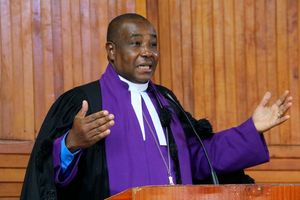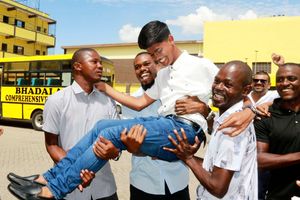Premium
14 and counting! Gor Mahia are now new AFC (Always Firing Coaches) but in name
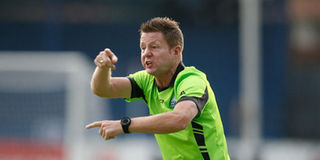
Gor Mahia coach Dylan Kerr gives instruction from the touchline during their Kenyan Premier League match against Bandari at Kenyatta Stadium, in Machakos on March 3, 2018.
What you need to know:
- Matano had a few months’ stint before being bumped off for Dutch septuagenarian Jan Koops, whose relatively stable tenure lasted from 2011 to 2013, decorated with a wonderful 23-match unbeaten run
- Gor Mahia are always firing coaches, now on their 14th tactician in 11 years following last week’s hiring of Roberto Oliveira
- Logarusic made changes to the team that new coach Scot Bobby Williamson, signed in 2013, fine-tuned for K’Ogalo’s first Kenyan title in 18 years
The rivalry between AFC Leopards and Gor Mahia is legendary. It has sustained the survival, growth and passion of the beautiful game in Kenya in the post-colonial era.
These two teams are the most decorated in the country, have perpetually represented Kenya in continental competitions, have produced the highest number of internationals and are seemingly immortal.
Through thick and thin, come rain or shine, in sickness and in health, the two mortal enemies have bestridden the local football scene, their fortunes rising and ebbing on a shore filled with shells of many promising football clubs that died without even a whimper.
Feisal, Ramogi, Nakuru All Stars (the original one), Kisumu Hotstars, Abeingo, Hakati, Transcom, Bata Bullets and Motcom, all came and went. Others include KTM, Scarlet, Volcano United, Reunion, Oserian Fastac, Utalii, Rivatex, Mumias Sugar, Mafuko Bombers, Utalii and Nakumatt, but I digress.
Exchange of barbs
I dare say, the rivalry between Ingwe and K’Ogalo is truly the soul of Kenyan football.
This tempestuous relationship of the self-declared “in-laws” that has inflamed the passions, stoked the teasing banter and incited the exchange of barbs has inevitably descended into full pitched battles on many a match day.
The team that wins invariably claims they have married the other club – meaning it is the woman in the relationship -- to much chagrin from the losing side. You wonder if this matters in an age when we have equality of the sexes.
I remember in the lead-up to the first Mashemeji derby of the 2015 season how Gor Mahia followers, their club very much on the ascendancy, had a field day hauling barbs at hated AFC Leopards fans.
One particular one that was as witty as it was apt was twisting the real meaning of the abbreviation AFC to “Always Firing Coaches”.
It was a field day for the Green Army as their blogs, dinner table conversations and bar counter banters dissected AFC and why they kept losing.
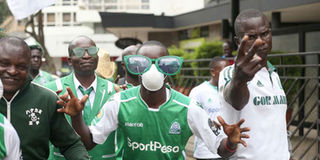
Gor Mahia fans dance along Kimathi street in Nairobi ahead of Mashemeji Derby against AFC Leopards on March 8, 2020.
AFC Leopards prepared for that derby under Dutchman Pieter de Jongh who was then the club’s 13th coach in six years!
Gor fans gleefully chortled at this remarkably revolving door of coaches at the Den, starting with the sacking of Gilbert Selebwa in 2009, the year the club was promoted to top flight football.
Next in was Edward Manoah, who survived for just a few months before Nick Yakhama took over to steer the club away from the relegation zone.
Yakhama was roughly shoved aside at the beginning of the new season to make way for the late Chris Makokha, only for the former physics teacher to be displaced by Robert Matano, a league winner with Sofapaka just a year back.
Matano had a few months’ stint before being bumped off for Dutch septuagenarian Jan Koops, whose relatively stable tenure lasted from 2011 to 2013, decorated with a wonderful 23-match unbeaten run.

Jan Koops during a training session during his days as AFC Leopards coach.
He too went, his place taken by Tom Timam (formerly Tom Olaba) for a miserly four months. Nicholas Muyoti was brought in in a caretaker capacity until Belgian Luc Eymael took over.
Eymael did not see the 2013 season through. Next came former Kenya striker James Nandwa, followed by ex-Harambee Stars goalkeeper Washington Muhanji in quick succession before De Jongh sat on the hot seat at the beginning of 2015.
Who could blame the Gor fans for their “always firing coaches” jibe?
But what is happening at Gor right now? They are always firing coaches, now on their 14th tactician in 11 years following last week’s hiring of Roberto Oliveira.
The unknown Brazilian took over from Brit Steve Polack, who had held the job for just about a year.
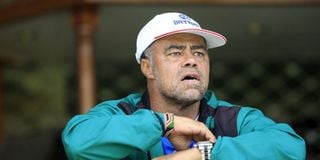
Gor Mahia coach Steven Polack gestures during their friendly match against Ksports at Parklands Sports Club in Nairobi on March 11, 2020.
Before him was the Cypriot-Turk Hasan Oktay who was in charge for one season.
This “AFC” period started when Gor legend James Siang'a was kicked out in 2009 after a two-year stint that, ironically, laid the foundation for future success.
He was replaced by Raphael Auko who lasted a few stormy matches before former club assistant coach Gideon Ochieng was brought in to hold fort.
Club old boy Zedekiah “Zico” Otieno went from technical director to coach in 2010. He lasted two years, managing a fourth place finish in the league in 2011. But it was not good enough for the impatient, glory-hungry fans and he was promptly ejected.
In came Cameroonian Anaba Awono only to suffer the same fate as Otieno in 2012 mid-season. Legendary “Six Million Dollar Man” John “Bobby” Ogolla was drafted in on an interim basis before the straight talking Croatian Zdravko Logarusic was hired – he of the famous words “I cannot have players who cannot think when running.”
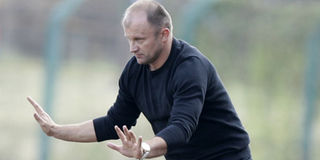
Gor Mahia coach Zdravko Logarusic gestures during their Tusker Premier League tie against Muhoroni Youth at City Stadium on November 4, 2012.
The Croat made changes to the team that new coach Scot Bobby Williamson, signed in 2013, fine-tuned for K’Ogalo’s first Kenyan title in 18 years.
Williamson was replaced by fellow Scot Frank Nuttal who guided the green jerseys to another national championship in 2014. The following year he won the Premiership unbeaten.
Nuttal parted ways with Gor in early 2016. Brazilian Jose Marcelo Ferraira was next in line. No title for him though.
Charismatic Brit Dylan Kerr replaced the Brazilian in 2017 and won back-to-back KPL crowns. Despite the achievement Gor replaced him with Oktay.

Gor Mahia coach Dylan Kerr gives instruction from the touchline during their Kenyan Premier League match against Bandari at Kenyatta Stadium, in Machakos on March 3, 2018.
Always firing coaches Gor Mahia have talked about building a modern stadium and club house. They have talked about transforming into a modern, professional outfit. They even hired a new CEO Ray Oruo to drive that process. But how will new “AFC” achieve these if they cannot even keep a coach?
PS The AFC in Leopards as so named in 1980 stands for All Footballers Co-operative.



